Nikon NIKKOR 80-400mm f/4.5-5.6G ED VR II Review
Nikon AF-S NIKKOR 80-400mm f/4.5-5.6G ED VR Performance
At 80mm and maximum aperture, sharpness in the centre of the frame is already outstanding, and the clarity towards the edges of the frame approaches excellent levels. Stopping down the aperture to between f/8 and f/11 results in outstanding sharpness across the frame.Performance is much the same with the lens zoomed to 200mm, with excellent sharpness in the centre of the frame and clarity not being far behind towards the edges of the frame at maximum aperture. As is the case at 80mm, peak clarity across the frame is achieved between f/8 and f/11, where sharpness across the frame is outstanding.
Finally, zooming to 400mm does result in an overall reduction in sharpness, but the lens still performs well. At f/5.6 clarity is very good in the centre of the frame, and good towards the edges of the frame. Stopping down to f/11 results in peak performance across the frame for this focal length, with excellent sharpness in the centre and very good clarity towards the edges of the frame.
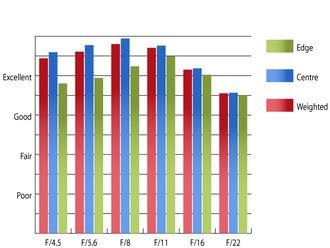 MTF@80mm | 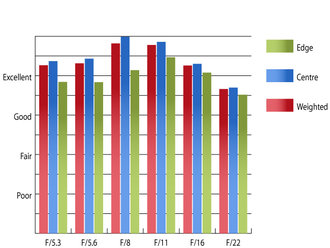 MTF@200mm |
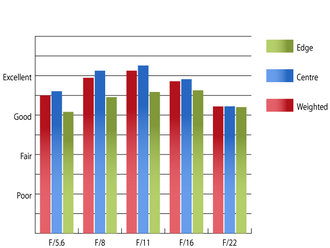 MTF@400mm | How to read our chartsThe blue column represents readings from the centre of the picture frame at the various apertures and the green is from the edges. Averaging them out gives the red weighted column.The scale on the left side is an indication of actual image resolution. The taller the column, the better the lens performance. Simple. For this review, the lens was tested on a Nikon D600 using Imatest. |
For a super-telephoto lens covering this range, chromatic aberrations are remarkably well controlled. Fringing is at its most prevalent towards the edges of the frame at 80mm with the aperture stopped down to f/16 or beyond. Even then half a pixel width of fringing is barely exceeded.
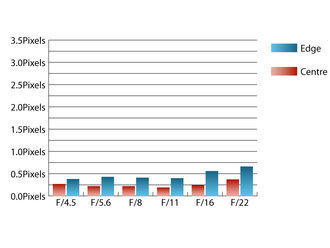 CA@80mm | 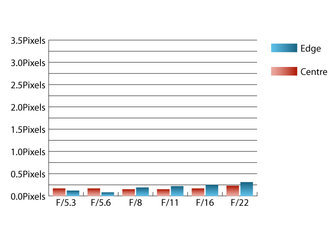 CA@200mm |
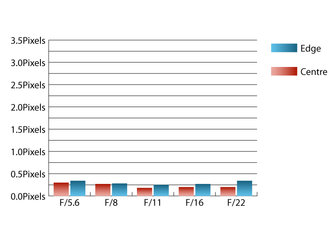 CA@400mm | How to read our chartsChromatic aberration is the lens' inability to focus on the sensor or film all colours of visible light at the same point. Severe chromatic aberration gives a noticeable fringing or a halo effect around sharp edges within the picture. It can be cured in software.Apochromatic lenses have special lens elements aspheric, extra-low dispersion etc. to minimize the problem, hence they usually cost more. For this review, the lens was tested on a Nikon D600 using Imatest. |
Falloff of illumination towards the corners is reasonably well controlled for a telephoto zoom lens. At 80mm and maximum aperture the corners are only 1.3stops darker than the image centre and visually uniform illumination is achieved with the lens stopped down to f/8 or beyond. At 400mm the corners are 1.66stops darker and visually uniform illumination is achieved with the aperture stopped down to f/11 or beyond.
Imatest detected fairly consistent pincushion distortion throughout the zoom range between 0.6% at 80mm and 0.768% at 400mm. This low level of distortion shouldn't pose too many issues. If absolutely straight lines are paramount, you'll be glad to hear the distortion pattern is uniform throughout the zoom range, which should make applying corrections in image editing software afterwards relatively straightforward.
Thanks to Nikon's Nano-crystal coating, incidences of flare and ghosting are a rare occurrence. Contrast holds up very well, even when shooting into the light at maximum aperture. A deep hood with a slight petal cut-out comes supplied with the lens, which does a decent job of shading the lens from extraneous light that may cause issues.
Add your message
Login required
Please login here or if you've not registered, you can register here. Registering is safe, quick and free.
Please login here or if you've not registered, you can register here. Registering is safe, quick and free.
photodo Stats
1102 lenses
428 MTF tests
74 in-depth photodo reviews
100+ users join each day
Help the lens community by reviewing or rating a lens today via our lens search
428 MTF tests
74 in-depth photodo reviews
100+ users join each day
Help the lens community by reviewing or rating a lens today via our lens search
Latest Lens Reviews
- Chinon 28mm f/2.8 Vintage Lens Review
- Canon EF 70-200mm f/4L IS II USM Lens Review
- Samyang AF 85mm f/1.4 EF Review
- Sigma 70mm f/2.8 DG Macro Art Review
- Samyang AF 24mm f/2.8 FE Review
- Meike 50mm f/1.7 Review
- Tamron 70-210mm f/4 Di VC USD Review
- Lensbaby Burnside 35mm f/2.8 Review
- Asahi Super Takumar 50mm f/1.4 Review
- Asahi Super-Multi-Coated Takumar 135mm f/3.5 Review
